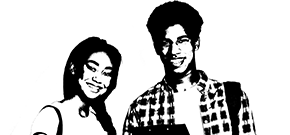EVENT ONE was created from the futuristic awe of the new computer, mixed with the bohemian, freethinking arts scene of 1960s London. Bringing together a combination of artists, scientists, architects and more in a show that consisted of visual arts, architecture of the future, music and sound exploration; it was an extravagant exploration of the new - interwoven with dreams of computing in the future.
Fast forward 50 years to 2019 and an established computer arts scene that has blossomed beyond all recognition. Held at The Royal College of Art from 12th-19th July, EVENT TWO was a greater, more encompassing collaboration including Art in FLUX, the Electronic Visualisation and Arts conference (EVA), Interact Digital Arts and Lumen Art Projects, all with the Royal College of Art (RCA). Exciting, all-encompassing and inspiring.
What was EVENT TWO like?
‘Well, it really was a great success.’ Sums up Graham Diprose, one of the pivotal figures in the creation of the anniversary event. ‘We asked George Mallen, who was a founding member of the Computer Arts Society to open EVENT TWO, because he opened EVENT ONE 50 years ago.
On the Monday evening, we had a panel discussion hosted by the Art in FLUX organisation with a range of guest artists. The Tuesday evening was the Computer Arts Society opening, attended by over 200 people. Wednesday featured some workshops to get the public involved, as well as the Lumen Prize longlist, featuring their own guest speakers.
‘In the middle of all of it, we had a day with Royal College of Arts students who had been invited to the V&A to see the historic print room, where all the original Computer Arts Society pictures are archived. Nick Lambert, chair of CAS, gave a lecture putting it all in context.
How far did EVENT TWO pay homage to its predecessor?
‘There were sound pieces in EVENT ONE that inspired us to include sound pieces in EVENT TWO, which we wouldn't have done otherwise. We also looked at the spirit of experimentation in the original and that’s what we chose to do in a different way. Yes, the technology has changed - they used architects’ plotters with three or four colour pens for ONE - while today we have some amazing pieces of tech. But all of the artists wanted to explore.’
What was different or surprising about the new event?
‘In my opinion, the Art in FLUX Event. There were lots and lots of different installations, workshops and debates. A lot of Computer Arts Society work was displayed around the walls, with some installations out in the centre. I think what we managed to capture with EVENT TWO was really a snapshot of the most cutting-edge digital art in London and the UK today.
‘I’m really very pleased that the show has been accepted by historians, the RCA and the V&A as EVENT TWO; which is something one doesn't really know will happen until it does.’
Collaborating ideas, utilising the same space
Another big art event that happened in London the week before EVENT TWO, was the 29th conference of EVA London - held deliberately prior, so that the delegates from one conference could experience the 50th anniversary of the other. ‘We had four evenings of EVA London that crossed over with a preview of EVENT TWO on the last day, Friday the 12th. We had students and staff over from Guangdong University in China, as well as a large number of artists and friends. EVENT TWO was also open to the public and enjoyed a pretty heavy footfall throughout Saturday, Monday, Tuesday and Wednesday.’
The two events ran over a total of nine days. ‘It was exhausting,’ Diprose admits, ‘but at the same time, the lovely thing that's come out of it is that everyone is very excited about the collaboration and the huge amounts of co-operation that made it happen. So, Art in FLUX, Lumen Prize, Computer Arts Society, Royal College of Art, V&A and EVA London are all keen to continue doing collaborations together and to see where we take it from here.’
‘The excitement the Computer Arts Society has about its subject is mirrored in many of the specialist groups that BCS facilitates across the UK. BCS is a wide organisation, devoted to supporting all areas of IT from the practical to the futuristic, the academic to the esoteric. With such a wide remit, it would be easy for our members to work in silos; however, it’s the collaboration and sharing of ideas that brings all the members together at BCS, for the good of the industry and for society.
‘Continuing as a direct spin off of EVENT TWO, it has been agreed that the Computer Arts Society and their fellow collaborators from the RCA exhibition will organise a rolling exhibition of historical and cutting-edge Digital Arts throughout the new BCS London headquarters building in Copthall Avenue. The first show should be in place by the time most BCS members make their first visit there in early September.
‘I don’t think that the Computer Arts Society is very well known in many parts of BCS, so, using EVENT TWO as a catalyst, I’d like to work with BCS to create an exhibition that would change every quarter. We might have a theme to do with EVA papers or the Lumen Prize; it would be fantastic if some of our younger artists from FLUX who've joined the Computer Arts Society could also be exhibited. The idea of a mini gallery in the centre of London that we can curate and work on for years to come seems like an absolutely brilliant idea.
‘The first exhibition will feature early CAS work, many items from 30-50 years ago. We will follow this up over the winter with work from the middle years in the 1980s and 90s and have some of today's artists contributing brand new work.
‘While the exhibition would be engaging for IT professionals who may not be familiar with CAS’ work, it could also be a way to bring more talent into BCS and a way to diversify certification and perception of education within the charity.’
Diprose continues: ‘I’d like to get the heads of the digital arts post-graduate courses in London to come along once a quarter and try to engage with the many digital arts post-grad students in London, encouraging them to get involved with BCS. Generally, digital arts students don't fit into the model of those who get qualifications through BCS, because they're using wildly different software and doing wildly different things. However, if we can actually engage with them properly, we can form closer links with education and refresh the Computer Arts Society, which will be mutually beneficial for us all.’
So, what’s next for the Computer Arts Society?
‘Before EVENT TWO, we had a prequel at Southampton Street, where we put together a panel of British digital historians and invited Jasia Reinhardt as the EVA guest speaker. Jasia was the original curator of Cybernetic Serendipity, which was the very first digital art show in the UK, held in August 1968 - the very show that inspired the formation of The Computer Arts Society.
‘That event made us realise that we need to bring more art historians onto our organising committee, to curate the work and to protect it for the future. Digital art is, by its make-up, a precarious thing; we don’t want art works to be lost by the turning-off of a server.
‘We also need to curate the new work as well as EVA papers - some of which go back 30 years. We are working on a project to locate and archive early papers, because I have a hunch that amongst them will be some amazingly inspired ideas that are ten years ahead of their time.’
So, will we need to wait another 50 years for EVENT THREE?
‘To see everyone there, V&A, Lumen Prize, Royal College of Art, CAS, Art in FLUX, all working together, all collaborating together and all wanting to continue, made us consider running an EVENT 2.1. But at the same time, it would just be fantastic to have lots of lovely informal collaborations in-between all the partners for many years to come.’

















